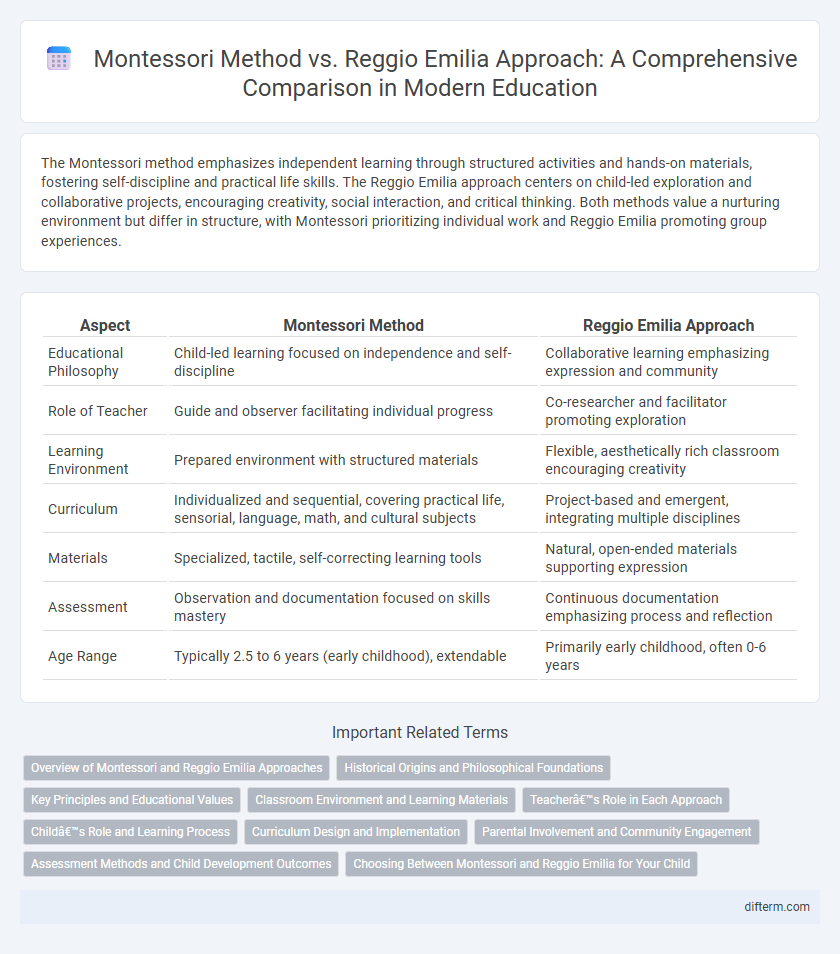The Montessori method emphasizes independent learning through structured activities and hands-on materials, fostering self-discipline and practical life skills. The Reggio Emilia approach centers on child-led exploration and collaborative projects, encouraging creativity, social interaction, and critical thinking. Both methods value a nurturing environment but differ in structure, with Montessori prioritizing individual work and Reggio Emilia promoting group experiences.
Table of Comparison
| Aspect | Montessori Method | Reggio Emilia Approach |
|---|---|---|
| Educational Philosophy | Child-led learning focused on independence and self-discipline | Collaborative learning emphasizing expression and community |
| Role of Teacher | Guide and observer facilitating individual progress | Co-researcher and facilitator promoting exploration |
| Learning Environment | Prepared environment with structured materials | Flexible, aesthetically rich classroom encouraging creativity |
| Curriculum | Individualized and sequential, covering practical life, sensorial, language, math, and cultural subjects | Project-based and emergent, integrating multiple disciplines |
| Materials | Specialized, tactile, self-correcting learning tools | Natural, open-ended materials supporting expression |
| Assessment | Observation and documentation focused on skills mastery | Continuous documentation emphasizing process and reflection |
| Age Range | Typically 2.5 to 6 years (early childhood), extendable | Primarily early childhood, often 0-6 years |
Overview of Montessori and Reggio Emilia Approaches
The Montessori method emphasizes individualized learning through hands-on activities and self-directed exploration, fostering independence and practical life skills in children. The Reggio Emilia approach centers on collaborative, project-based learning that values children's interests and community involvement, promoting creativity and critical thinking. Both approaches prioritize child-centered education but differ in structure and classroom environment, with Montessori focusing on prepared materials and Reggio Emilia on expressive arts and social collaboration.
Historical Origins and Philosophical Foundations
The Montessori method, developed by Dr. Maria Montessori in the early 1900s in Italy, emphasizes self-directed learning, sensory-based education, and respect for a child's natural psychological development. The Reggio Emilia approach, founded by Loris Malaguzzi after World War II in northern Italy, focuses on collaborative, project-based learning and the child as an active participant in constructing knowledge within a community. Both educational philosophies prioritize child-centered learning but differ fundamentally in their historical contexts and views on the teacher's role--Montessori highlights structured independence, while Reggio Emilia values social interaction and expressive communication.
Key Principles and Educational Values
The Montessori method emphasizes individualized learning, hands-on activities, and fostering independence through a prepared environment with self-correcting materials. In contrast, the Reggio Emilia approach values collaborative group work, creative expression, and the role of the environment as the "third teacher," promoting inquiry-based learning and strong community connections. Both methods prioritize child-centered education but differ in their implementation of structure and social interaction.
Classroom Environment and Learning Materials
The Montessori method emphasizes a structured classroom environment with specially designed, hands-on learning materials that promote independent exploration and practical life skills. The Reggio Emilia approach features a flexible, aesthetically rich classroom that encourages collaboration and creativity through open-ended materials reflecting the child's interests. Both environments prioritize child-centered learning but differ in their organization and use of materials to foster development.
Teacher’s Role in Each Approach
The Montessori method positions the teacher as a guide who carefully prepares the learning environment and observes students to support independent exploration and self-directed learning. In contrast, the Reggio Emilia approach views the teacher as a co-learner and collaborator who facilitates dialogue, encourages creativity, and supports projects driven by children's interests. Both methods emphasize observation but differ in the degree of structure, with Montessori focusing on individual autonomy and Reggio Emilia promoting community interaction and expressive communication.
Child’s Role and Learning Process
The Montessori method emphasizes independence, allowing children to choose activities that foster self-discipline and hands-on learning through specially designed materials. The Reggio Emilia approach prioritizes collaboration and expression, encouraging children to explore ideas through social interaction and creative projects within a nurturing environment. Both methods view the child as an active participant in their education, but Montessori leans toward individual discovery while Reggio Emilia highlights community and shared meaning-making.
Curriculum Design and Implementation
The Montessori method emphasizes individualized, self-paced learning through hands-on materials and a structured environment, promoting autonomy and sensory development. The Reggio Emilia approach centers on project-based, collaborative learning driven by children's interests, fostering creativity and social interaction within a flexible curriculum framework. Both methodologies prioritize child-led exploration but differ in curriculum flexibility and teacher's role, with Montessori following a predefined sequence and Reggio Emilia adapting dynamically to students' evolving ideas.
Parental Involvement and Community Engagement
The Montessori method emphasizes structured parental involvement through guided home activities and consistent communication, fostering a stable learning environment. In contrast, the Reggio Emilia approach actively integrates parents and the broader community as collaborators in the educational process, encouraging shared decision-making and experiential projects. Both methods recognize parental and community engagement as crucial, yet Montessori prioritizes individual child independence while Reggio Emilia promotes collective exploration and social interaction.
Assessment Methods and Child Development Outcomes
The Montessori method utilizes standardized observational assessments and self-correcting materials to foster independent learning and intrinsic motivation, promoting cognitive and practical life skills development. In contrast, the Reggio Emilia approach emphasizes portfolio assessments and documentation of children's work, highlighting creativity, social collaboration, and emotional growth. Both methods support holistic child development but differ in assessment techniques and the specific developmental outcomes they prioritize.
Choosing Between Montessori and Reggio Emilia for Your Child
Choosing between the Montessori and Reggio Emilia methods depends on your child's learning style and developmental needs. Montessori emphasizes structured, independent learning with hands-on materials, fostering self-discipline and practical life skills. Reggio Emilia nurtures creativity and collaboration through child-led projects and expressive arts, encouraging social interaction and critical thinking.
Montessori method vs Reggio Emilia approach Infographic

 difterm.com
difterm.com